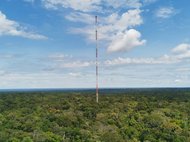ESRP-Projects
Within the ESRP, the institute collaborate on several large-scale projects that require multidiscilinary expertise.
Successful Earth system research requires a combination of three methodologies.
- First, field measurements and experiments must be carried out. Observational methods mostly in the form of field campaigns and controlled experiments, in laboratory or field, complement each other.
- Second, it is necessary to analyze the Earth on large time and space scales to understand regional, global and long-term processes and variations. The long time scales and high levels of natural variability in the Earth system call for long-term measurements at carefully selected locations and the analysis of natural archives, such as ice cores or sediment profiles. Satellites are essential for the measurement of large-scale phenomena.
- The third pillar of Earth system research is numerical modelling. It is the fundamental theoretical tool with which we investigate the interrelationships in the Earth system. Modelling is the only ‘language’ in which the complex processes in the Earth system and its components can be qualitatively and quantitatively expressed.
The Partnership is active in all three fields. Following are projects the ESRP has set up or is heavily involved in:
Research Airplane HALO
HALO, the High ALtitude – long-range research aircraft opens new horizons for the German atmospheric research community. The Gulfstream G550 can transport three tons of scientific equipment up to 15.5 kilometers altitude, over distances of more than 10.000 kilometers. Several air intakes and equipment mountings allow diverse studies of the traversed air masses.
ZOTTO - Zotino Tall Tower Observatory
In order to monitor on a regional scale biogeochemical and climate changes in central Siberia, the 300 meter high Zotino Tall Tower Observatory (ZOTTO) has been established near 60°N, 90°E, about 20 km west of the river Yenissei and about 600 km north of Krasnoyarsk. It continuously measures the concentration of biogeochemically important green-house gases in the surface and planetary boundary layer. Project web page
